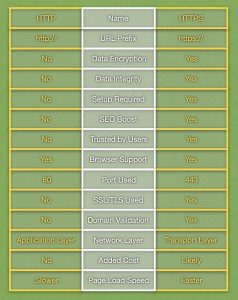HTTP is short for Hypertext Transfer Protocol and offers a standardized set of rules for data transfer across the web. If a client and a server communicate through HTTP, the information is transmitted in an unsecure manner. You can find out whether you are using HTTP by checking the website’s URL. If the URL begins with http://, then you are using HTTP. Also, recent versions of most web browsers have started labeling HTTP websites as Not Secure:

HTTPS is derived from HTTP and stands for Hypertext Transfer Protocol Secure. It performs the same function as HTTP with one major difference – HTTPS utilizes encryption to secure the connection between the client and the server. Websites that take advantage of HTTPS will have URLs that begin with https://. Moreover, web browsers will place a padlock icon in the address bar, signaling that your connection is secure:

HTTP is gradually being phased out since it transmits all data using plain text. In other words, when you are browsing a website through HTTP, third parties will be able to eavesdrop on your communication with the server and read all data that is sent back and forth. This is a serious security concern, especially if the transmitted data contains sensitive information such as login credentials or financial details.
To make matters worse, third parties can not only monitor the information that is transmitted, but they can alter it as well. Therefore, when you are viewing a website through HTTP, there is a chance that the webpage has been tampered with. As such, HTTP cannot guarantee data integrity.

Fortunately, HTTPS is able to guard against such man-in-the-middle attacks and eavesdropping attempts by encrypting all data that is transmitted. Encrypted traffic can still be intercepted by third parties, however, they will not be able to decipher the captured data. As a result, the third party can neither read nor alter the information. The only two entities that are able to use the data are the sender and the intended recipient.

Data encryption in HTTPS is facilitated by an SSL certificate. Each website that offers HTTPS must have a valid SSL certificate installed. An SSL is considered valid if it is issued for the exact domain name where it is used. In contrast, HTTP does not require the use of an SSL certificate and as such it does not provide domain authentication and encryption capabilities.
The use of HTTPS brings another notable advantage to website owners – better search ranking. Several years ago, Google announced that it will view the use of HTTPS as a ranking signal when displaying search results. Since then, the importance of HTTPS in SEO has risen even more. Nowadays, having an HTTPS-enabled website is a must for everyone who wishes to be featured prominently in search results.
SEO benefits aside, HTTPS must be used by websites that collect sensitive visitor information such as payment details or login credentials. So, if you run an online store where you carry out financial transactions or you have a website where visitors can register and share personal details, then you must ensure that your website runs on HTTPS.
Get a Hosting Plan with a Free SSL!
At this point, the use of HTTP is acceptable only in small personal websites that are commonly hosted on our free hosting platform. Such websites do not transmit sensitive information and are not aiming to rank high in search results.
Since HTTPS communication not only sends data back and forth but also encrypts and decrypts the information, it is normal to assume that HTTPS will be slower when compared to HTTP. That is not the case, however. While HTTPS does require more processing power during encryption and decryption, the data transfer itself is faster because HTTPS skips the filtering and scanning steps that typically occur with HTTP. As such, large websites with many multimedia elements tend to perform better with HTTPS rather than HTTP.

For more information on what the difference is between HTTP and HTTPS as well as what makes HTTPS secure, continue reading or jump to the section that interests you.
- What Is HTTP?
- What Is HTTPS?
- What Makes HTTPS Secure?
- Should I Start Using HTTPS on My Website?
- How Do I Enable HTTPS on My Website?
- Conclusion
What Is HTTP?
HTTP, or Hypertext Transfer Protocol is a set of rules that web browsers and servers follow in order to exchange information. HTTP is a TCP/IP-based protocol and is suitable for the transmission of text as well as multimedia elements like audio, video, images, and others. Communication through HTTP occurs in the Application Layer on Port 80.

The main issue with HTTP is that it focuses only on the successful delivery of the information and does not incorporate any protections against eavesdropping or tampering. Due to this reason, HTTP is considered to be an unsecure protocol. To learn even more, you can read our article on what is HTTP.
What Is HTTPS?
HTTPS, or Hypertext Transfer Protocol Secure, builds upon HTTP to deliver the same set of features while also bringing tremendeous security improvements. It functions in the Transport Layer and uses Port 443 for communication.

HTTPS leverages SSL/TLS to provide a secure connection where all transmitted information is fully encrypted. In other words, man-in-the-middle and eavesdropping attacks are not possible on HTTPS connections. To learn even more, read our in-depth article on HTTPS.
What Makes HTTPS Secure?
HTTPS is made secure thanks to the use of SSL/TLS certificates. Every owner of an HTTPS-enabled website must get an SSL certificate and then install it onto the web server. Once the server is equipped with an SSL/TLS certificate, it can start using HTTPS for communication with clients like web browsers.
When a web browser tries to load an HTTPS-enabled website, the server first sends its SSL certificate to the web browser. The browser then verifies that the certificate is valid and is issued for the correct domain. Once these checks have been completed, a level of trust has been established between the server and the client and the two proceed to negotiate an encrypted connection.
In a secure connection, only the server and the client possess the session keys necessary to encrypt and decrypt the transmitted data. The encryption is bi-directional, which means that it includes both the requests sent by the web browser as well as the responses received by the web server. If a third party that lacks the session keys tries to eavesdrop on the communication, they will not be able to decipher the data that is exchanged.

Should I Start Using HTTPS on My Website?
If your website takes payments or you plan on adding such functionality in the future, then you should definitely enable HTTPS on your website. Not having HTTPS makes it easy for third parties to steal your clients’ financial information. What is more, the lack of HTTPS will be a big deterrent for most online shoppers and as a result, your sales will be heavily diminished.
Another do-or-die scenario where the use of HTTPS is a must is when your website collects sensitive information from visitors. The data can include usernames, passwords, emails, real names, addresses, phone numbers, medical records, etc. Should your website collect any such information, you must enable HTTPS to ensure secure data transmission through the web. HTTPS will be able to ensure not only the data’s security but its integrity as well.
The use of HTTPS is also recommended if you wish to rank high in search results. Major search engines like Google consider the presence of HTTPS a ranking signal and will give HTTPS-enabled websites a boost in SERPs.
Start Your Own Website For Free!
Lastly, even if your website does not fall into any of the above categories, you should still consider using HTTPS. All major search engines and web browsers are making gradual changes in the way they treat HTTP pages. While HTTP was once the norm, nowadays it is seen as undesirable and obsolete due to its lack of security. As such, not getting HTTPS is simply delaying the inevitable. At some point in the not-too-distant future, all reputable websites will be using HTTPS regardless of the content they display. And therefore, it is a good idea to make the switch as soon as possible in order to avoid any future penalties that may be imposed by search engines and web browsers.
How Do I Enable HTTPS on My Website?
It all starts with getting an SSL certificate. If you are using one of our premium shared hosting plans, a semi-dedicated server, or a VPS package, then you can request a free SSL from the Technical Support Team.
Alternatively, you can purchase an SSL certificate through our website. Some of the SSL certificates that we sell feature extended validation (EV). These certificates will not only verify that you are the owner of your domain name, but they will also carry out verification of your company, proving it is a legitimate business. Some web browsers may showcase this extended validation by featuring the company name in the browser address bar.

If you have trouble acquiring an SSL, you can refer to our in-depth walkthrough on getting an SSL certificate.
After an SSL certificate is issued for your domain name, you need to install it. The process is fairly straightforward and is outlined in our guide on installing an SSL certificate. If you have any trouble with the process, you can always reach out to the Technical Support Team.
Once the SSL is installed successfully, all that is left to do is to redirect your HTTP traffic to HTTPS. The way you do this differs depending on the type of website you have. We have outlined the most common scenarios in our article on redirecting HTTP traffic to HTTPS.
Conclusion
The difference between HTTP and HTTPS mainly comes down to the level of security each protocol affords. HTTP was created in the dawn of the Internet when security wasn’t much of a concern. Since then, the Internet has exploded in popularity which has led to the need to have more protective measures in place.
HTTPS was created to address this need for enhanced security. It provides the same functionality as HTTP but also introduces improvements such as bi-directional data encryption, domain verification, and data integrity checks.
Going forward, it is clear that HTTPS will replace HTTP as the de facto protocol for data transfer across the web. As such, we highly recommend upgrading your website to use HTTPS if you are still stuck with HTTP.